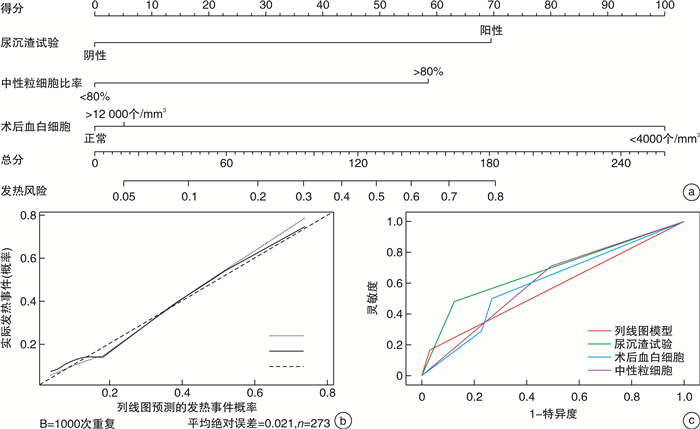Evaluation of the risk factors of progress from post-RIRS shivering to fever and establishment of nomogram prediction model
-
摘要: 目的 评估输尿管软镜碎石术(RIRS)术后寒战进展至发热的危险因素,并构建了列线图预测模型对RIRS术后发热作出早期预判。方法 回顾性分析2018年1月—2021年12月广州医科大学附属第一医院273例RIRS术后寒战患者资料,比较发热组和非发热组的临床资料,采用多因素logistic回归分析确定发热的危险因素,并构建列线图预测RIRS术后寒战到发热的进展。结果 在多因素logistic回归分析中,术前尿沉渣试验阳性(OR=4.99,95%CI:1.77~14.79,P<0.01)、术后血白细胞计数异常(OR=2.51,95%CI:1.15~5.57,P=0.02)和术后中性粒细胞比率>80%(OR=2.59,95%CI:1.15~6.18,P=0.03)被确定为RIRS术后寒战进展至发热的独立危险因素。结论 对于RIRS术后寒战患者,术前尿沉渣试验阳性和术后血常规检查阳性(白细胞计数>12 000个/mm3或 < 4000个/mm3,或中性粒细胞比例>80%)即可对术后感染做出鉴别诊断。Abstract: Objective To explore the independent risk factors of progress from post-RIRS shivering to fever and construct a nomogram to early predict the fever episodes.Methods Two hundred and seventy-three cases with post-RIRS shivering in First Affiliated Hospital of Guangzhou Medical University from January 2018 to December 2021 were reviewed, and clinical data were compared between fever group and non-fever group. Risk factors were identified by multivariate logistic regression analysis, and a nomogram was constructed to early predict the progress from post-RIRS shivering to fever.Results In multivariate logistic analysis, preoperative positive urine sediment test (OR=4.99, 95%CI: 1.77-14.79, P < 0.01), postoperative abnormal WBC count (OR=2.51, 95%CI: 1.15-5.57, P=0.02) and postoperative neutrophil ratio > 80% (OR=2.59, 95%CI: 1.15-6.18, P=0.03) were identified as independent risk factors of the progress from post-RIRS shivering to fever.Conclusion For patients with post-RIRS shivering, preoperative positive urine sediment test and postoperative blood routine test (WBC count > 12 000 cells/mm3 or < 4000 cells/mm3, or neutrophil ratio > 80%) were able to make a quick differential diagnosis of post-RIRS infection.
-
Key words:
- retrograde intrarenal surgery /
- complication /
- postoperative shivering /
- postoperative fever /
- infection
-

-
表 1 2组患者一般资料比较
例(%),X±S 项目 总体(273例) 非发热组(225例) 发热组(48例) P值 年龄/岁 50.21±12.93 50.37±12.69 49.44±14.09 0.67 男/女 149/124 128/97 21/27 0.13 BMI/(kg·m-2) 23.63±3.39 23.78±3.43 22.78±3.24 0.06 糖尿病 26(9.52) 18(8.00) 8(16.67) 0.11 高血压 43(15.75) 35(15.56) 8(16.67) 1.00 既往碎石史 172(63.00) 139(61.78) 33(68.75) 0.46 手术患侧 0.60 左侧 143 120 23 右侧 130 105 25 结石直径/mm 18.46±12.92 17.65±12.51 22.29±14.26 0.02 结石面积/mm2 138.6±135 128±124 190±171 0.04 多发结石 178(65.20) 143(63.56) 35(72.92) 0.32 术前留置内支架 109(39.93) 88(39.11) 21(43.75) 0.66 尿沉渣试验阳性 51(18.68) 28(12.44) 23(47.92) < 0.01 尿培养阳性 63(23.08) 41(18.22) 22(45.83) < 0.01 手术时间/min 29.08±16.58 27.96±15.62 34.33±19.94 0.04 灌注量/mL 991±602 951±582 1178±660 0.03 结石成分 0.31 草酸钙结石 127(46.52) 107(47.56) 20(41.67) 感染性结石 34(12.45) 26(11.56) 8(16.67) 胱氨酸结石 1(0.37) 0(0) 1(2.08) 尿酸结石 16(5.86) 13(5.78) 3(6.25) 其他 95(34.80) 79(35.11) 16(33.33) 结石清除率 175(64.10) 145(64.44) 30(62.50) 0.93 血常规白细胞异常 74(27.11) 52(23.11) 22(45.83) < 0.01 中性粒细胞比率>80% 145(53.11) 111(49.33) 34(70.83) 0.01 术后使用地塞米松 257(94.14) 214(95.11) 43(89.58) 0.25 术后使用泼尼松 16(5.86) 11(4.89) 5(10.42) 住院时间/d 2.71±2.28 2.32±1.69 4.51±3.53 < 0.01 SIRS(G-Ⅱ) 25(9.16) 0 25(52.08) < 0.01 脓毒症(G-Ⅱ) 9(3.30) 3(1.33) 6(12.50) < 0.01 感染性休克(G-Ⅳ) 3(1.10) 0 3(6.25) < 0.01 术后抗生素/d 2.61±2.25 2.13±1.29 4.53±3.84 < 0.01 表 2 RIRS术后寒战进展到发热的logistic回归分析
参数 单变量logistic分析 多变量logistic分析 OR 95%CI P值 OR 95%CI P值 性别 1.69 0.91~3.21 0.10 1.44 0.66~3.17 0.36 BMI 0.91 0.82~1.00 0.07 0.96 0.85~1.08 0.49 糖尿病 2.30 0.89~5.50 0.07 2.03 0.64~6.08 0.21 结石直径/mm 1.02 1.00~1.05 0.03 1.01 0.96~1.07 0.60 结石面积/mm2 1.01 1.00~1.01 < 0.01 1.01 0.99~1.01 0.45 尿沉渣阳性 6.47 3.25~13.02 < 0.01 4.99 1.77~14.79 < 0.01 尿培养阳性 3.79 1.95~7.37 < 0.01 0.68 0.21~1.98 0.49 时间/min 1.02 1.01~1.04 0.02 1.01 0.97~1.04 0.64 灌注量/mL 1.01 1.00~1.01 0.02 1.01 0.99~1.01 0.88 中性粒细胞比率>80% 2.49 1.29~5.04 < 0.01 2.59 1.15~6.18 0.03 血常规白细胞异常 2.75 1.45~5.23 < 0.01 2.51 1.15~5.57 0.02 -
[1] Turk C, Petrik A, SaricaK, et al. EAU Guidelines on Diagnosis and Conservative Management of Urolithiasis[J]. Eur Urol, 2016, 69(3): 468-474. doi: 10.1016/j.eururo.2015.07.040
[2] 赵志健, 曾国华. 《2021 EULIS与IAU联合专家共识: 输尿管软镜碎石术》解读[J]. 临床泌尿外科杂志, 2022, 37(2): 83-85. https://lcmw.whuhzzs.com/article/doi/10.13201/j.issn.1001-1420.2022.02.001
[3] Baş O, Tuygun C, Dede O, et al. Factors affecting complication rates of retrograde flexible ureterorenoscopy: analysis of 1571 procedures-a single-center experience[J]. World J Urol, 2017, 35(5): 819-826. doi: 10.1007/s00345-016-1930-3
[4] Scotland KB, Lo J, Grgic T, et al. Ureteral stent-associated infection and sepsis: pathogenesis and prevention: a review[J]. Biofouling, 2019, 35(1): 117-127. doi: 10.1080/08927014.2018.1562549
[5] Caruselli M. Postoperative shivering: a common phenomenon with multiple causes[J]. Minerva Anestesiol, 2018, 84(12): 1340-1342.
[6] Singer M, Deutschman CS, Seymour CW, et al. The Third International Consensus Definitions for Sepsis and Septic Shock(Sepsis-3)[J]. JAMA, 2016, 315(8): 801-810. doi: 10.1001/jama.2016.0287
[7] Wagenlehner FM, Tandogdu Z, Bjerklund Johansen TE. An update on classification and management of urosepsis[J]. Curr Opin Urol, 2017, 27(2): 133-137. doi: 10.1097/MOU.0000000000000364
[8] Corrales M, Sierra A, Doizi S, et al. Risk of Sepsis in Retrograde Intrarenal Surgery: A Systematic Review of the Literature[J]. Eur Urol Open Sci, 2022, 44: 84-91. doi: 10.1016/j.euros.2022.08.008
[9] Wu H, Wang Z, Zhu S, et al. Uroseptic Shock Can Be Reversed by Early Intervention Based on Leukocyte Count 2 h Post-operation: Animal Model and Multicenter Clinical Cohort Study[J]. Inflammation, 2018, 41(5): 1835-1841. doi: 10.1007/s10753-018-0826-3
[10] Chawdhary S, Panigrahi PK, Sharma K, et al. Prognostic Role of Procalcitonin and C-reactive Protein in Surgical Neonates: A Single-Institution Experience[J]. Cureus, 2022, 14(8): e28319.
[11] 任淑霞. 术中升温毯联合等体温灌洗液在输尿管软镜钬激光碎石术患者的应用效果[J]. 临床与病理杂志, 2022, 42(7): 1714-1718. https://www.cnki.com.cn/Article/CJFDTOTAL-WYSB202207030.htm
[12] Tokas T, Herrmann T, Skolarikos A, et al. Pressure matters: intrarenal pressures during normal and pathological conditions, and impact of increased values to renal physiology[J]. World J Urol, 2019, 37(1): 125-131. doi: 10.1007/s00345-018-2378-4
[13] Croghan SM, Skolarikos A, Jack GS, et al. Upper urinary tract pressures in endourology: a systematic review of range, variables and implications[J]. BJU Int, 2022.
[14] Sobieski MA 2nd, Graham JD, Pappas PS, et al. Reducing the effects of the systemic inflammatory response to cardiopulmonary bypass: can single dose steroids blunt systemic inflammatory response syndrome?[J]. ASAIO J, 2008, 54(2): 203-206. doi: 10.1097/MAT.0b013e3181640331
[15] Annane D, Bellissant E, Bollaert PE, et al. Corticosteroids for treating sepsis in children and adults[J]. Cochrane Database Syst Rev, 2019, 12(12): CD002243.
[16] 徐辉, 谢天朋, 肖日海, 等. 小剂量地塞米松预防经皮肾镜取石术并发全身炎症反应综合征的疗效观察[J]. 微创泌尿外科杂志, 2018, 7(6): 389-392. https://www.cnki.com.cn/Article/CJFDTOTAL-WCMN201806008.htm
-





 下载:
下载: